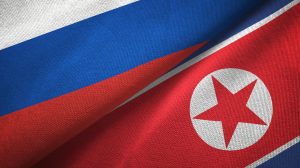Footage released in late July indicated that the Russian Armed Forces have acquired Bulase-4 anti-tank missiles and associated combat vehicles from North Korea, and have begun utilizing them on the frontlines in Ukraine. The implications of this acquisition are significant not only for the frontlines in Ukraine, but also for what it reveals regarding North Korea’s defense sector and its future both as a supplier to the Korean People’s Army and as a major exporter.
The Bulsae-4 is a Non Line of Sight (NLOS) anti-tank guided missile (ATGM) with an estimated range of over 10 kilometers. It appears broadly equivalent to the U.S. FGM-148 Javelin and Chinese HJ-12.
The ability to fire on targets without line of sight allows Bulsae-4 systems to be used from cover, including from within buildings, while relying on reconnaissance drones to spot targets. The high potential of such missiles made headlines in 2022 when Ukrainian forces used the Javelin to great effect against Russian armor beginning in late February, causing major losses and leading the weapons system to gain particular prestige in the country.
Although the Soviet Union’s anti-tank missile systems consistently led the world in performance during the Cold War, post-Soviet Russia’s position had notably deteriorated from the 1990s. While enhanced variants of its main handheld anti-tank missile, the Kornet, have proven formidable in combat, their reliance on line of sight for targeting remains a serious limiting factor, disadvantaging them against their top Chinese and U.S. counterparts.
Where the Javelin is limited to a 4.5 kilometer range, which is comparable to that of the Kornet, the Bulsae-4 has a range closer to that of the HJ-12 at over 10 kilometers, making it likely to turn Russia’s disadvantage in the field into a strong advantage.
Footage from the frontlines in Ukraine appears to show the Bulsae-4 deployed from a specially modified North Korean six-wheeled combat vehicle, much as it has been when paraded through Kim Il Sung Square. The Bulsae-4 is being used to engage Ukrainian positions from well beyond visual range. Ukrainian sources have indicated that the vehicles would fire six missiles and quickly withdraw before being targeted, with footage showing Ukrainian howitzers being destroyed approximately 10 kilometers behind the frontlines using such attacks.
A number of prior kills against Ukrainian vehicles as early as May also appear to have been achieved using non line of sight ATGMs. While it was previously speculated by some sources that Javelin missiles captured by Russian forces could have been responsible, the appearance of the Bulsae-4 in the theater indicates that the North Korean system may have been responsible for those earlier strikes as well.
Exports of the Bulsae-4 provide a further demonstration of the rise of North Korea’s defense sector to produce equipment that is not only on par, but in many cases has significant capability advantages, compared to its top counterparts in Russian service. The KN-23B ballistic missile system and KN-25 rocket artillery system confirmed to have been deployed by Russian forces in early January are notable prior examples. Both enjoy far longer ranges among other advantages compared to analogous Russian systems.
Analysts have long identified non line of sight ATGMs as one of the assets that could be most valued by Russia if acquired from abroad. The HJ-12 accordingly is seen as the one Chinese system that the Russian Defense Ministry would likely be most eager to purchase should Beijing lift its embargo on arms sales to the two warring parties. While likely not as capable as the latest variants of the HJ-12, the Bulsae-4 more than bridges the gap in handheld anti tank missile capabilities between Russia and Ukraine, further raising North Korea’s value as an arms supplier.
The Bulsae-4, as its name implies, is the fourth in a line of North Korean handheld anti-tank missile classes. Its predecessor the Bulsae-3 is considered broadly analogous to the Russian Kornet with several design similarities.
The deployment of the Bulsae-4 in Ukraine, following growing interest in Javelin-like systems worldwide from 2022, has the potential to stimulate significant foreign interest in the North Korean system, following successful exports of its predecessors to the Middle East and Africa in particular. With Russia’s defense sector focused heavily on supplying the country’s own forces for ongoing hostilities in Ukraine, it is likely that a growing number of clients will consider acquiring the Bulsae-4. It also helps that Russia, as a permanent member of the United Nations Security Council, has been acquiring North Korean equipment, which has seriously diminished the taboo surrounding such imports.
Russia itself, meanwhile, may pursue a technology transfer deal and license production domestically, much as it did with Iranian single drones, to reduce reliance on imports and close key capability gaps in areas where its defense sector was previously behind those of its adversaries.
In February 2023, I observed that China could learn from successful U.S.-led efforts to arm Ukraine to independently halt Russian advances, and apply these lessons to the Korean Peninsula by supplying the HJ-12 to North Korean forces on a large scale should a U.S.-led invasion appear possible. North Korea’s development of a comparably capable system ingeniously, however, largely eliminates the need for this.
Much as mass deployments of the Javelin in Ukraine played a central role in shaping the balance of power on the ground in Ukraine in 2022, so too is the Bulsae-4’s introduction in Korea a game changer, with the system posing one of the greatest threats to U.S., South Korean, and allied armor in the event of conflict. The peacetime consequences of the system’s deployment could be wide ranging, from efforts to develop up-armored variants of the South Korean K2 tank to counter the threat, to a focus on developing longer ranged anti-tank missiles to bridge the range gap with North Korean forces.

































